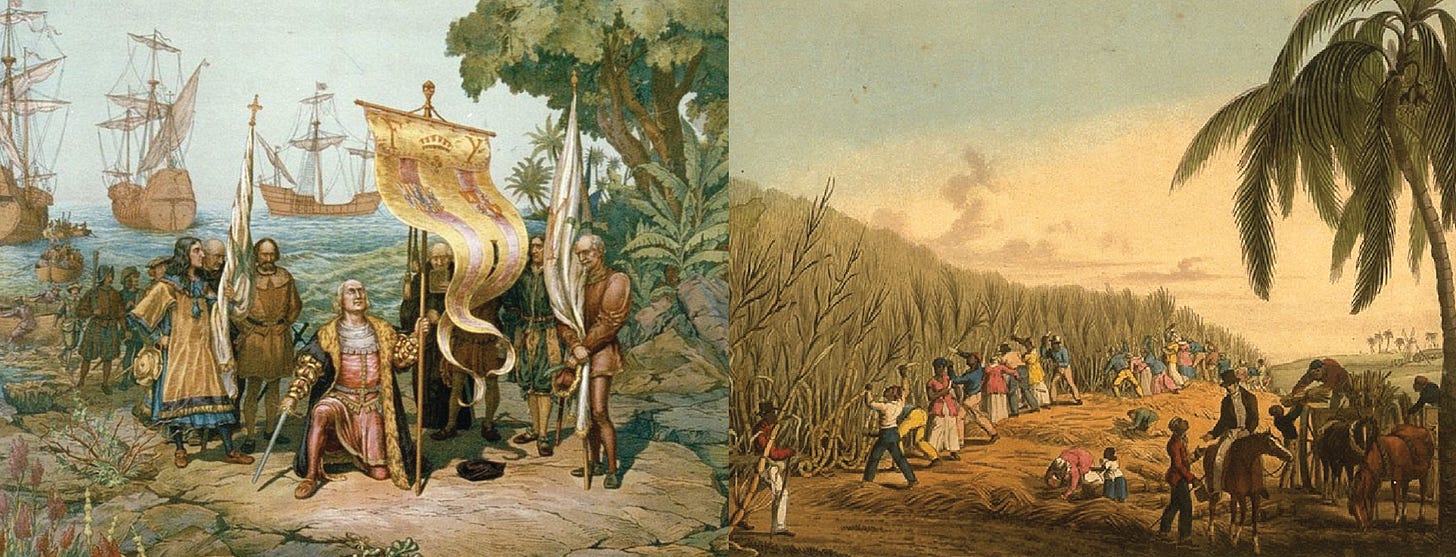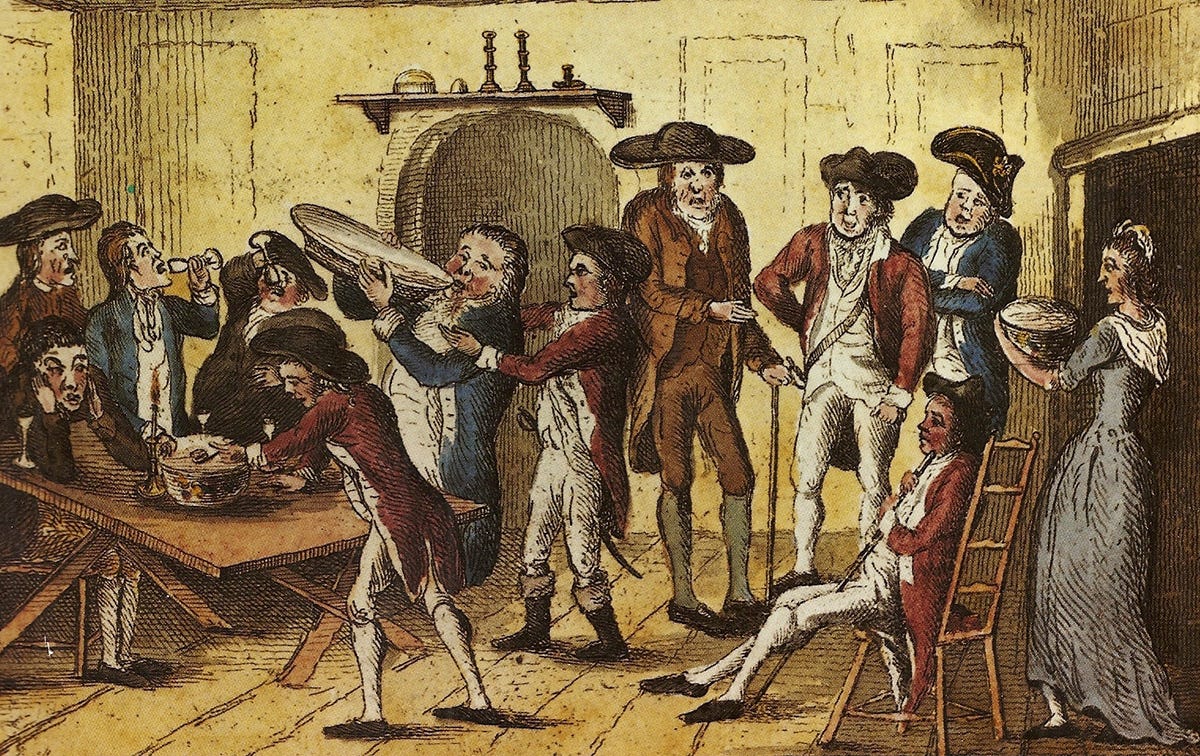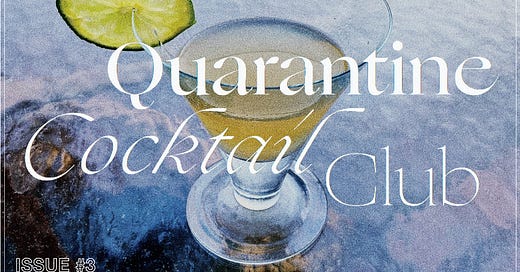Revolution Punch
How rum – and the enslaved people who produced it – laid the foundations for the American Revolution.

Greetings subscribers. After a three-week-long hiatus, QCC has arrived in your inbox once again. Before we begin, a quick explanation for this silence:
The digital universe feels like a drastically different place than the one in which Quarantine Cocktail Club was conceived just a few months ago. In the wake of the tragic deaths of Amaud Arbery, Breonna Taylor, and George Floyd, we have all witnessed an unparalleled display of national outcry, including millions attending protests in all 50 states.
George Floyd’s murder has also triggered a surge of internet activism unlike anything my generation has experienced, and it has certainly evoked some mixed feelings for me. On one hand, I’m inspired by the support my white peers have been showing in solidarity with our Black friends, neighbors, and classmates. I’m appreciative of the countless compilations of resources that have been circulating with information about how white people like myself can use our privilege most effectively in this moment. Most of all, I am immensely grateful for my Black friends who have voluntarily expended scarce emotional energy on conversations with me about how I can be a better ally.
But I’ve also been struggling with this outpouring of social media solidarity, as many people and brands alike are using black squares and hashtag activism to let themselves off the hook, without any actual accountability. As a result, the rules of social media have felt increasingly and impossibly complex. Where is the line between lending one’s platform to amplify Black voices and participating in virtue signaling? Is it problematic to maintain an inactive social media presence, even if offline, you’re donating and protesting? If there is anything I’ve learned in the past few weeks, it's that I have a long way to go in understanding how to navigate these situations.
Through trial and error, I’ve been learning to become more mindful of the virtual real estate I occupy, which is why I chose to put QCC on pause. But over the past several days, I’ve realized that the impetus behind starting Quarantine Cocktail Club was, among other things, to unearth fragments of history that we aren’t taught in school, and bring them to light.
The historical moment we are now living through should encourage us to reevaluate our assumptions and educate ourselves, so I feel as though there’s no better way that I can use this platform than to share the troubling history of one of America’s most beloved spirits. The history of rum is inextricably tied with the history of slavery, the systemic oppression of Black people, and the exploitative impacts of capitalism in this country. If you’re interested in learning about how enslaved people working on Caribbean sugar plantations shaped the America we know today, read on.
Meet the Cast: Rum
The exact origin of rum is uncertain – like vodka, it is likely that many cultures across multiple continents discovered rum at around the same time. However, one Indonesian spirit called Batavia Arrack was created from a melange of distilled sugarcane and red rice in the late 16th century and is often described as the first “proto rum” spirit.
By Christopher Columbus’s time, sugar cane, native to the India and Southeast Asia, was already flourishing in the warm climate of the Canary Islands and was considered a highly valuable commodity. Columbus’ sponsors, the King and Queen of Spain, wanted him to establish the crop in their new colonies in the Caribbean to bring in new revenue streams. Thus, on his second voyage to the New World in 1493, Columbus brought sugar cane to Hispanola (modern day Haiti and the Dominican Republic). The earliest record of industrial-scale rum trade, however, wasn’t until 1630.
If you were a nerd in high school like myself, you will recall from AP U.S. History that sugar was one of the components in the new world system of triangular trade. Molasses, a byproduct of sugar production, was shipped to New England where it was distilled into rum. The profits from the rum were then used to finance manufactured goods that the merchants traders would ship to West Africa and exchange for enslaved people. These traders would then ship enslaved Africans to the Caribbean where they were forced to work on their sugar plantations. The vicious cycle continued.

Note that colonial images depicting slavery were often created and distributed by white slaveowners and intentionally misrepresented sugar cane plantations in order to maintain public support of the slave trade.
Hundreds of thousands of enslaved men, women, and children were brought from Africa to the Caribbean and American South to work on sugar cane plantations. The tiny British colony of Barbados was commonly described as "the most important jewel in his Majesty's crown," housing 175 sugar plantations and 77,000 slaves. What’s worse, enslaved people working on sugar cane plantations were forced to extract the sugar juice and process the liquid in addition to planting, tending, and harvesting the cane. Some historians have described the grueling labor of harvesting sugar cane as equivalent to running a half marathon every single day of the week. Others have described it as closer to “running while inhaling dangerous smoke from burning the sugar cane, with the risk of cutting yourself with a machete, being bitten by snakes and scorpions, and without enough water and protein to keep you hydrated and give you energy.” Essentially, these plantations were farms and factories rolled into one, and since the weather was tropical, enslaved people were forced to work in these horrific conditions all year round.
These sugar plantation owners had two major problems: rats and molasses. It turned out that rats have a sweet tooth: 5% of the processed sugar was consumed by vermin. Enslaved people were tasked with eradicating them by hand or with metal clubs. Molasses, on the other hand, presented an even greater nuisance – the process of refining two pounds of sugar produced an entire pound of the messy, sticky waste product, and no one knew what to do with it.
That is, until planters realized that the excess molasses was actually a goldmine. The waste product they had been feeding to enslaved workers and throwing into the ocean for years could be distilled into rum, so the sticky sludge was shipped up to New England for distillation. The cheap liquor that resulted was colloquially called “Kill Devil” or “Rumbullion” (meaning “rowdy brawl”) and was described as “hot, hellish, and horrible.” The rum and sugar trades combined to form a crucial edge of the triangular trade system that would help the American colonies gain financial independence from Great Britain.

Fueling the Revolution
At the dawn of the 18th century, Great Britain became suspicious of the bourgeoning American rum trade. Intimidated by what appeared to be a direct route to financial independence, Parliament cracked down on the colonies with the 1733 Molasses Act. Parliament had hoped this would suppress trade between American and French-owned Caribbean colonies, but the act was poorly regulated. With little effort, colonists continued to smuggle molasses into their distilleries.
More than ever before, rum became considered a rebellious, edgy, and progressive beverage – a fitting drink for the budding revolutionary. During George Washington’s electoral campaign to the Virginia House of Burgesses, he supplied voters with 28 gallons of rum and 50 gallons of rum punch. And a quick fun fact that my fellow Penn students will appreciate: among Benjamin Franklin’s 228 synonyms for "drunk,” published in the Pennsylvania Gazette, was “been to Barbados.” Some historians estimate that the average American colonist was likely throwing back multiple pints of rum per week.

Art credit: Wes Duvall
By 1764, there were over 150 rum distilleries in New England, importing roughly 6.5 million gallons of molasses and pumping out 5 million gallons of rum annually. Angered by the colonists’ disregard for the Molasses Act (and glaring authority issues in general), Parliament escalated their response and passed the 1764 Sugar Act to crack down on the illegal smuggling fueling the colonial rum industry. The Sugar Act sparked immediate outrage among everyday colonists and influential political leaders alike, and was a critical factor leading up to the Revolutionary War.
As a result, modern historians often proudly describe rum as “the history of America in a glass.” While certainly true, this sentiment fails to divulge the systems of enslavement, exploitation, racism, and disenfranchisement exacerbated by the full, grisly scope of the history of rum production in America. Rum is not only a symbol of the American Revolution – it’s also a reminder that this country was built upon the backs of enslaved Black people, without whom the American Experiment would have undoubtedly failed.
Dad Dispatch: Cuba Libre
When I was in college my favorite bar drink was a “Cuba Libre.” Though disparaged as an uninspired rum cocktail, it’s a convenient choice. Coke, white rum, and limes can be found at any bar, even in the standing room only commuter bars in bus terminals. (When I had a class early the next morning, the later rounds of Cuba Libre I ordered the night before were just Coke and lime so nobody could accuse me of not keeping up.)
“Cuba Libre” (“Free Cuba”) was the rallying cry for Cuba’s independence from Spain during the Spanish American War of 1898. Besides providing America with an excuse to engage in some hemispherical colonialism, the cocktail has historical importance in American mixology. The Cuba Libre was likely invented in Havana at the turn of the 20th century, just after the war, when the US still had a large military and economic presence there.
Coca-Cola (mostly made with Cuban-grown sugar) was just being exported to Cuba, not insignificantly because it was one of the only safe beverages to drink on a tropical island rife with yellow fever, typhoid, malaria, and dysentery. (Only 379 U. S. soldiers had died in the recent fighting; the total number of deaths by disease was 5,083.)
The trading schooners that brought Cuban molasses to New England to be distilled into rum also returned with ice cut from frozen freshwater ponds in Maine. These shipments were packed with insulating sawdust from Maine lumber mills that ensured the ice didn’t melt in transit. Thus, Cuba became one of the first tropical destinations to have a ready supply of ice for cocktails.
Limes were local produce; rum, Coke — and now ice — gave rise to a cocktail that, over time, has become one of the world’s most popular even to this day.
In my day, Cuba had a special significance in that Fidel Castro had recently taken over and turned it into a Communist satellite just 90 miles from Sloppy Joe’s bar in Key West, FL, where Hemingway spent a lot of time in the post-Prohibition years. (As a Spring Break destination, one could spend all one’s waking hours bar-hopping along Duval St. and never taste the same rum cocktail twice — not that the historic KW-inspired Rum Runner cocktail wouldn’t get repeat calls.)
In the early 60s, there was a major Cold War freak out over Cuba resulting from a failed CIA-funded invasion by Cuban ex-pats from the Miami area. In retaliation, Castro invited the USSR to establish Soviet defensive missiles which nearly got the U.S. “in a shooting war with the Ruskies” — as we used to say. So, if you were a liberal college student in the early 60s and inclined to support the Cuban cause, ordering a Cuba Libre was a rallying cry repurposed from another era in the drink’s history.
By the late 60s, however, the Vietnam War emerged as a more relevant cause and the youth culture switched its allegiance from distilled spirits to weed. But that’s another story…although I don’t remember too much from those days. Sorry.
Recipes of the Week

“Ernest Hemingway put away 15 frozen daiquiris in one sitting, while John F. Kennedy sipped them when he beat Nixon in the 1960 presidential election—at least according to legend. Today, daiquiris are the beloved beverage of cocktail aficionados and wannabe vacationers to the newly reopened Cuba. Below, every single thing you need to know about one of the most classic of classic cocktails—history, tips and techniques, recipes, and variations.” – Eater Magazine

The first time mail was transported by air in the United States was in 1911. The plane in question flew from Santa Rosa to Petaluma, California, carrying three official pieces of correspondence. At the time, it was considered a modern day miracle. Cuba, not wanted to be left far behind the U.S., started their own airmail service in 1930. Following the first successful airmail flight in Cuba, the distillery giant Bacardi invented this celebratory cocktail – a light, frothy, summery drink using their main product – and published it in one of their promotional pamphlets. Thus, the Airmail was born.

If you’re still here, thank you for reading in light of the current state of the world. One last quick plug for some suggested actions to take:
If you have the means, please consider making donations to Black-led organizations leading the fight against police brutality and racial oppression - here is a non-exhaustive list.
If you are not able to donate, here is a comprehensive resource of other ways to take action.
Additionally, here is a compilation of educational resources for non-Black people featuring content by Black creators that I found helpful.
That’s all for this week!
Cheers,
Anna


